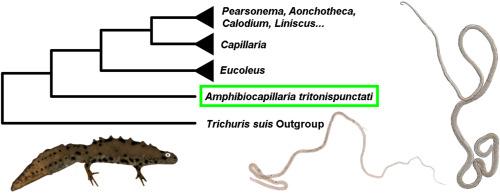An update on the phylogeny of capillariid nematodes based on 18S rDNA sequences of Amphibiocapillaria tritonispunctati (Diesing, 1851) and four other species
IF 1.7
Q3 PARASITOLOGY
Current research in parasitology & vector-borne diseases
Pub Date : 2025-01-01
DOI:10.1016/j.crpvbd.2025.100321
引用次数: 0
Abstract
The nematode family Capillariidae represents a taxonomically complex and understudied group of parasitic nematodes infecting a broad range of vertebrate hosts. Despite more than 300 described species, phylogenetic relationships within the family remain unresolved due to limited molecular data and ongoing taxonomic revisions. In this study, we generated new sequences of the 18S ribosomal RNA gene for Amphibiocapillaria tritonispunctati from the Danube crested newt, Triturus dobrogicus, and four additional capillariid species (Aonchotheca annulosa, Baruscapillaria inflexa, Eucoleus sp. 1 from the common starling Sturnus vulgaris, and Eucoleus sp. 2 from the black-headed gull Chroicocephalus ridibundus) from birds and rodents, expanding the molecular dataset for the group. Phylogenetic analyses using Bayesian inference and Maximum Likelihood methods revealed A. tritonispunctati as the earliest-diverging lineage within the Capillariidae, suggesting deep evolutionary divergence. Our results also supported the monophyly of Eucoleus and Capillaria and confirmed the distinctness of Baruscapillaria. Morphological examination of A. tritonispunctati corroborated its identification and highlighted the weight of diagnostic characters of the genus Amphibiocapillaria. Our findings underscore the need for broader molecular sampling and integrative taxonomy to clarify capillariid systematics and host-parasite relationships, particularly among nematodes from cold-blooded vertebrates.

基于Amphibiocapillaria tritonispunctati (Diesing, 1851)和其他4个物种的18S rDNA序列的毛线虫系统发育研究进展
毛线虫科是一种分类复杂且研究不足的寄生线虫,感染广泛的脊椎动物宿主。尽管已有300多个物种被描述,但由于有限的分子数据和正在进行的分类修订,该家族内部的系统发育关系仍未得到解决。在这项研究中,我们生成了来自多河冠蝾螈、dobrogicus、以及来自鸟类和啮齿动物的另外四个毛细管物种(Aonchotheca annulosa、Baruscapillaria inflexa、普通椋鸟Sturnus vulgaris的Eucoleus sp. 1和黑头鸥Chroicocephalus ridibundus的Eucoleus sp. 2)的18S核糖体RNA基因序列,扩大了该群体的分子数据集。利用贝叶斯推理和极大似然方法进行系统发育分析,发现毛缕甲是毛缕科中分化最早的分支,表明毛缕甲的进化分化程度较深。我们的研究结果也支持了桉树属和毛细属的单一性,并证实了毛细属的独特性。对三角棘蝽的形态学检查证实了它的鉴定,并强调了Amphibiocapillaria属的诊断特征。我们的发现强调需要更广泛的分子采样和综合分类来澄清毛细系统和宿主-寄生虫关系,特别是在冷血脊椎动物的线虫中。
本文章由计算机程序翻译,如有差异,请以英文原文为准。
求助全文
约1分钟内获得全文
求助全文

 求助内容:
求助内容: 应助结果提醒方式:
应助结果提醒方式:


